Lithium battery's leading greenhouse gas data has been released, and BYD has become the only company emitting more than 10 million tons.| ESG Xinpai Observation
According to the EU's New Battery Law, power batteries are the first product to explicitly require the disclosure of carbon footprint values. Emission data of lithium battery products has attracted much attention in the industry.
According to statistics, as of now, among the top 15 list of domestic power battery loading volumes released by the China Automotive Power Battery Industry Innovation Alliance in 2023, a total of seven companies have released 2023 ESG-related theme reports, respectively Ningde Times (300750.SZ), BYD (002594.SZ), Yiwei Lithium Energy (300014.SZ), Guoxuan High-Tech (002074.SZ), Xinwangda (300207.SZ), Funeng Technology (688567.SH) and Polyfluorodore (002407.SZ).
Among the above-mentioned enterprises, six companies have disclosed total greenhouse gas emissions, Scope 1 emissions and Scope 2 emission data, namely Ningde Times, BYD, Guoxuan High-Tech, Xinwangda and Funeng Technology.
Among them, Guoxuan High-Tech and Funeng Technology also disclosed greenhouse gas range 3 emissions, which were 18,200 tons and 987,500 tons respectively. In the calculation of total greenhouse gas emissions, Guoxuan High-tech includes Scope 3 emissions.
In terms of total emissions, BYD is the only company among the above-mentioned statistical companies whose total greenhouse gas emissions exceed 10 million tons. Both Guoxuan High-Tech and Ningde Times 'total greenhouse gas emissions last year also exceeded one million tons. Xinwanda and Funeng Technology have relatively small greenhouse gas emissions, both of which are less than 1 million tons.
BYD is the second largest domestic power battery manufacturer throughout the year and the world's largest pure electric vehicle manufacturer. Therefore, its greenhouse gas emissions include not only the power battery business, but also automobile manufacturing and other aspects.
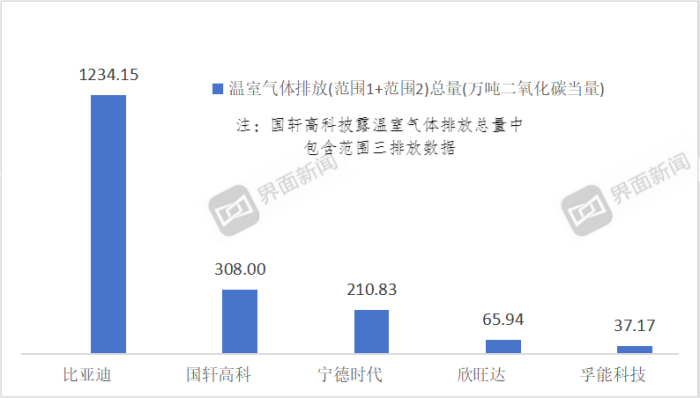
Specific to scope 1 emissions, BYD and Ningde Times rank first and second respectively, with emissions close to the million-ton mark. Guoxuan High-tech and Yiwei Lithium Energy ranked second, with direct greenhouse gas emissions of about 100,000 tons.
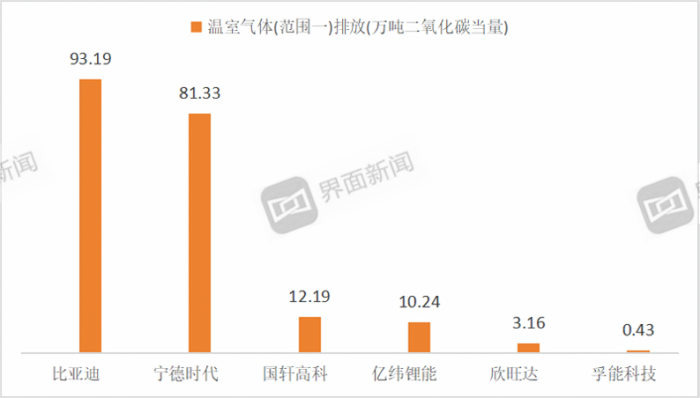
In terms of Scope 2 greenhouse gas emissions, BYD exceeded 10 million tons, far exceeding the other five companies. Followed by Yiwei Lithium Energy, Ningde Times and Guoxuan High-tech, indirect greenhouse gas emissions remain at one million tons. Xinwanda and Funeng Technology have greenhouse gas emissions of less than one million tons.
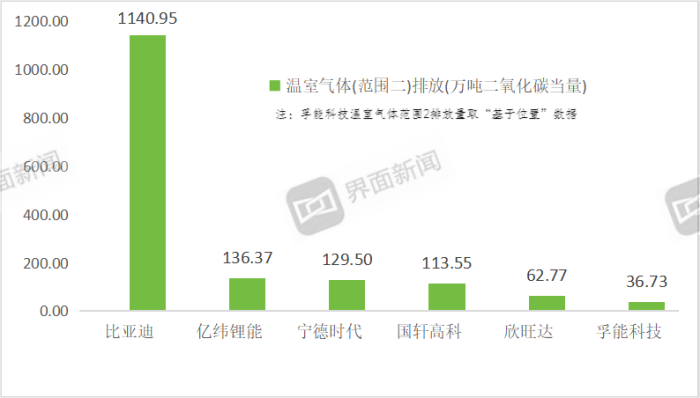
According to the greenhouse gas (GHG) accounting system of the international emission accounting tool, Scope 1 greenhouse gas emissions refer to the direct emissions generated by emission sources owned or controlled by the enterprise, that is, directly related to the enterprise's production process, covering emissions from the consumption of bituminous coal, diesel, natural gas, gasoline, and process emissions from cement production, etc.; Scope 2 refers to indirect emissions from purchased electricity, heat or cooling sources consumed by the company.
In terms of growth rates, BYD had the largest year-on-year increases in Scope 1 and Scope 2 emissions among the above-mentioned companies, with increases of approximately 69% and 52% respectively. Both indicators of Funeng Technology showed a downward trend.
BYD did not disclose the reasons for the large year-on-year increase. It said that emissions during operations mainly come from energy consumption. At the same time, in order to reduce energy consumption, 93 new energy-saving renovation projects will be added in 2023, achieving emission reductions of 132,500 tons.
Last year, Ningde's scope 1 emissions increased by 33% year-on-year, but scope 2 emissions fell by about 50% year-on-year. According to its disclosure, this mainly comes from the increase in the proportion of renewable electricity in the power structure.
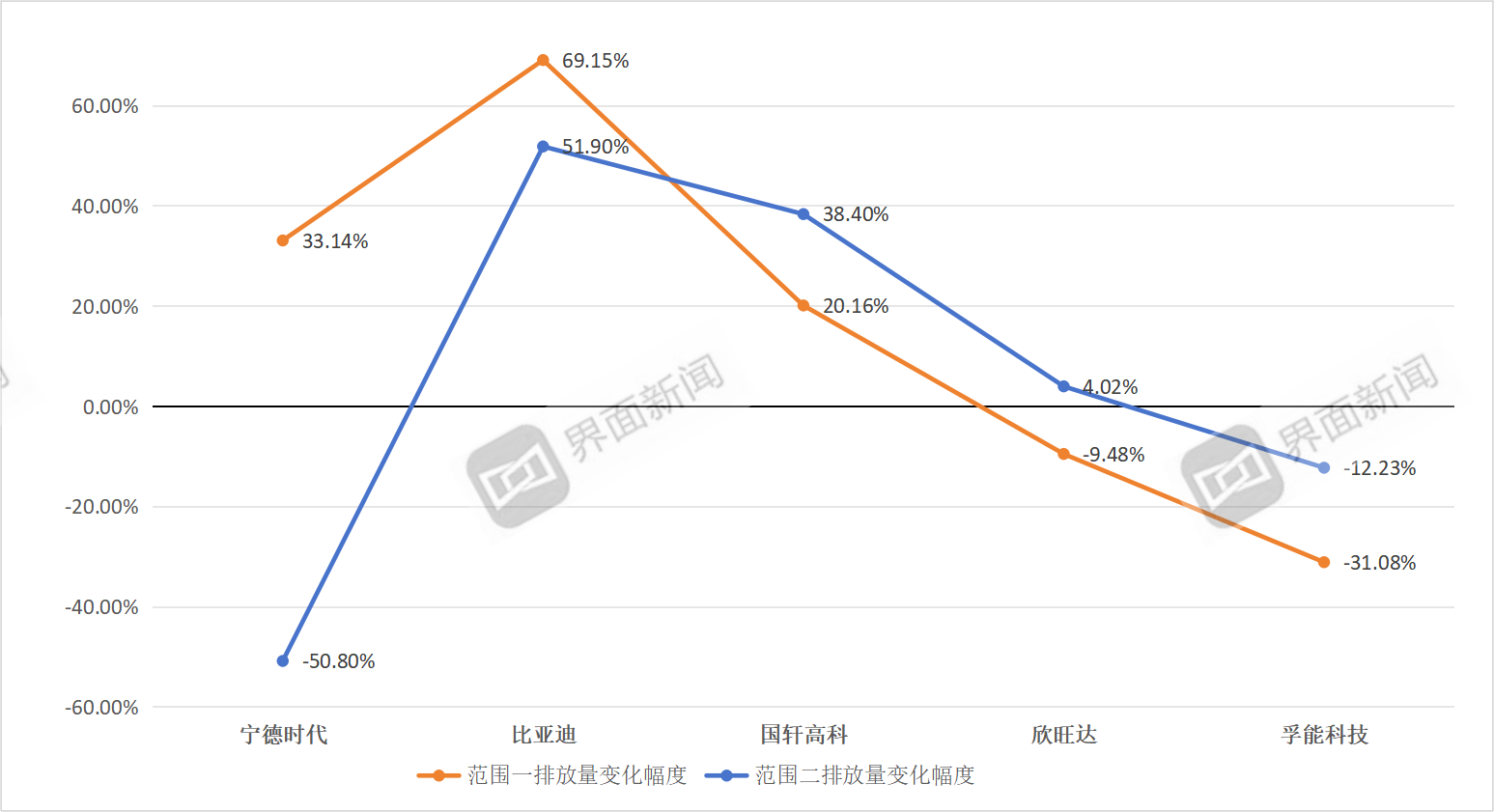
In addition, many companies have not disclosed scope 3 greenhouse gas emissions yet. For example, Ningde Times stated that the scope 3 greenhouse gas emissions of specific bases will be publicly disclosed after obtaining a third-party verification statement. Yiwei Lithium Energy also stated that the company's Scope 3 greenhouse gas emission data is subject to annual verification and will not be disclosed for the time being.
Interface journalists compiled and found that in terms of greenhouse gas emissions calculation, the emission factors and reference standards used by the above-mentioned companies are not completely consistent.
For example, Ningde Times refers to the "Guidelines for Accounting Methods and Reporting of Greenhouse Gas Emissions for Enterprises: Power Generation Facilities (Draft for Comments)"(2022), BYD refers to Shenzhen's "Guidelines for the Organization of Greenhouse Gas Emissions Verification", and Yiwei Lithium Energy mainly refers to ISO 14064-1:2018 and the GHG Protocol. The sources of emission factors selected include the "IPCC 2006 National Greenhouse Gas Inventory Guidelines", the "Notice on Improving the Management of Greenhouse Gas Emissions Reports of Enterprises in the Power Generation Industry from 2023 to 2025" and the "Guidelines for Accounting Methods and Reporting of Greenhouse Gas Emissions of Machinery and Equipment Manufacturing Enterprises (Trial)" and other standards.
According to the European Transport and Environment Federation (TE) report, power battery carbon emissions are mainly concentrated in two aspects: battery production, assembly and production of key materials such as upstream positive and negative electrodes.
Ningde Times also disclosed in the report that scope 1 calculates natural gas and fugitive gas emissions consumed in the production process of battery products, and scope 2 calculates purchased electricity and steam emissions consumed in the production of battery products. The type of greenhouse gas calculated in the two is carbon dioxide. That is to say, the greenhouse gas emissions of the above-mentioned enterprises mainly come from the production of battery products, which is also a key link in the emission reduction of the power battery industry.
In 2023, the United Nations Global Compact released the "White Paper on Power Battery Carbon Footprint and Low Carbon Cycle Development", which predicts that the demand for electric vehicle batteries will show a rapid growth trend from 2020 to 2050.
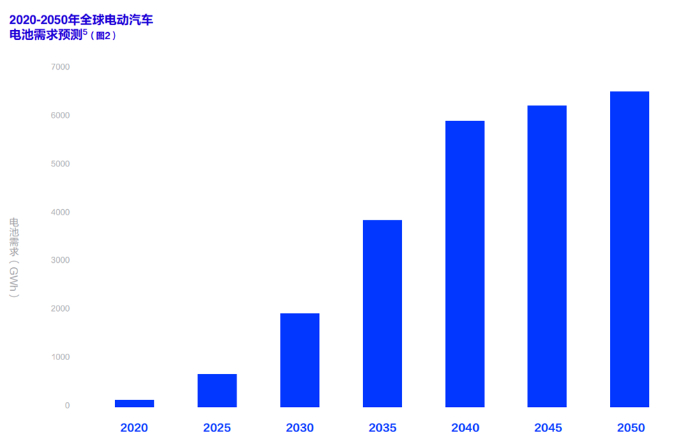
Starting from August 2023, the EU Battery and Waste Battery Regulation will officially come into effect. This means that starting from July 2024, only electric vehicle batteries with established carbon footprints can be put on the EU market. For battery companies, establishing a sound carbon footprint system cannot be avoided.
More urgently, in May this year, the draft EU carbon footprint calculation was officially released after the one-month consultation window. Twelve months after the official version of the document is released, power batteries sold in the EU market must provide a carbon footprint statement. The calculation of the carbon footprint of power battery products will be related to their future competitiveness in the EU market.
In response to the constraints of the above-mentioned EU regulations, Funeng Technology disclosed in the ESG report that it has established an EU Battery Regulation Working Group to evaluate mass production products and new projects affected by EU Battery Regulations (EU Restricted Substances), and form targeted response measures. Ensure the normal advancement of related projects.
From February to March 2023, Funeng Technology will carry out annual corporate carbon footprint verification work, conduct energy and carbon surveys with some key raw material suppliers, obtain carbon footprint information on the actual products of some suppliers, and improve the preparation of the current carbon inventory.
In addition, Ningde Times, BYD, Yiwei Lithium Energy and Xinwangda have also carried out explorations and practices in carbon footprint management, including calculation and accounting of the carbon footprint of related products, and participation in the preparation of relevant standards.







